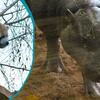Gráinne Hartigan (Nature’s SAFE) is joined by Lauren Amos (Clouded leopard EEP Coordinator) to discuss the new techniques saving clouded leopards.
The clouded leopard is a unique, tree-dwelling felid species native to the tropical forests of Southeast Asia, easily spotted by their characteristic cloud-like patterning and large canine teeth. Due to their dependence on tropical forests, they have faced alarming declines due to habitat loss, losing over 30% of their habitat in just two decades, compounded by severe fragmentation of remaining areas. Consequently, wild clouded leopards have very low genetic diversity globally, comparable in fact to African cheetahs. With an estimated wild population of less than 6000 across Asia, coordinated breeding programs are a crucial tool in the fight for their survival and population health.
However, breeding clouded leopards in zoos has proven challenging over the years. Aggressive by nature, introducing potential breeding pairs as adults is not without risk and most successfully achieved when under the age of seven. Suitable pairs need to be very carefully selected, not only in terms of their temperament but also their genetics and their geographic location. There are less than 110 Clouded Leopards across 44 wildlife parks in the European Ex-situ breeding programme, 25 of which can be found in the UK at ten different locations. With an average life expectancy of about fourteen years, there are only 28 cats under the age of seven years.
To address these challenges and maintain a viable ex-situ population, assisted reproductive technologies like artificial insemination offer a promising solution to facilitate gene flow. Successful pregnancies and live births have been achieved through ovulation induction and artificial insemination in clouded leopards. However, as they often have poor ejaculate quality and frequent sperm abnormalities, improved storage methods are needed to produce viable post-thaw sperm samples and enhance the success of artificial insemination.
Nature's SAFE, already partnered with four UK holders of clouded leopards, is collaborating with the clouded leopard EEP coordinator to expand these partnerships across the entire UK collection. Their goal is to cryopreserve biological material from the entire living collection of clouded leopards in the UK and support ex-situ breeding efforts through assisted reproductive technologies (ARTs).
“Clouded Leopards provide balance in the forests, one of nature’s care takers. It is our job to ensure the balance remains possible. To be able to preserve the genetics of the current Clouded Leopard EEP is not only an incredible achievement but it also gives us great hope for a healthy and diverse future.
Today’s Clouded Leopard population is struggling both demographically and genetically in the wild and in captivity. Nature’s SAFE and other biobanks are enabling this goal to be achieved through research, storage of genetic material and/or the creation of embryos from stored samples.
It is imperative that we act now to protect what we have for a chance at a better future.
The possibilities that Nature’s SAFE is providing is endless, the work accomplished gives purpose to the lives of the individuals that are no longer with us, ensuring their legacy carry’s on but more importantly they can help save species. “
- Lauren Amos, Clouded leopard EEP coordinator
Collaboration between breeding programme coordinators and external biobanking partners such as Nature’s SAFE can enhance long-term strategic conservation planning within UK zoos. As more advanced technologies become available, it is important to re-assess their role within conservation and leverage them when necessary to ensure species survival.
- Gráinne Hartigan, Nature’s SAFE
All blogs reflect the views of their author and are not necessarily a reflection of BIAZA's positions
-
News
 Belfast Zoo helps to bring Christmas joy to Children’s Hospital 19th December, 2025Belfast Zoo joined the Lord Mayor of Belfast, Councillor Tracy Kelly, on Monday (15th December) to help bring festive cheer to the Royal Belfast Hospital…
Belfast Zoo helps to bring Christmas joy to Children’s Hospital 19th December, 2025Belfast Zoo joined the Lord Mayor of Belfast, Councillor Tracy Kelly, on Monday (15th December) to help bring festive cheer to the Royal Belfast Hospital… -
News
 Colchester Zoological Society welcomes new arrivals 19th December, 2025This December, Colchester Zoological Society (CZS) welcomed some exciting new arrivals! A young male pygmy hippo, Mikolas, from Zoo Dvur Kralove…
Colchester Zoological Society welcomes new arrivals 19th December, 2025This December, Colchester Zoological Society (CZS) welcomed some exciting new arrivals! A young male pygmy hippo, Mikolas, from Zoo Dvur Kralove… -
News
.png?w=100&h=100&zc=1&f=jpeg&hash=8d175f93cde920c5ba23c8ea7f92e55a) Blog: Understanding the human side of zoos 16th December, 2025Why are zoo researchers increasingly looking to social science? Dr Nieky van Veggel explains the significance of understanding the human dimension…
Blog: Understanding the human side of zoos 16th December, 2025Why are zoo researchers increasingly looking to social science? Dr Nieky van Veggel explains the significance of understanding the human dimension…



